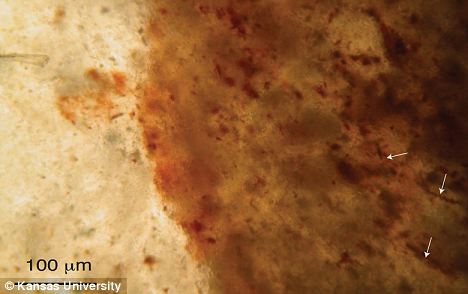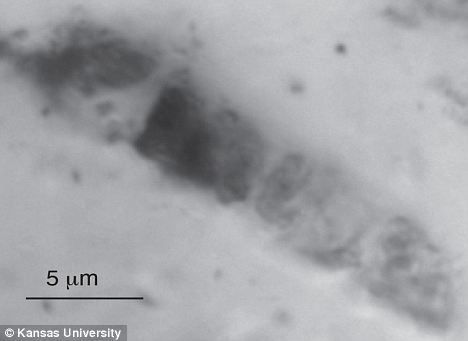http://www.dailymail.co.uk/sciencet...idence-life-turns-iron-deposits.html?ITO=1490
By Claire Bates
It was a discovery that scientists proclaimed was the oldest evidence of life on our planet.
But researchers who thought they had found 3.5 billion-year-old bacteria fossils in Australian rock have been left red-faced after U.S geologists debunked their findings.
A team from the University of Kansas said the microscopic structures are nothing more than tiny gaps in the rock that are packed with lifeless minerals.
 Not fossils: The arrows point to the spots in the rock that were thought to be evidence of the earliest life on Earth. The scale shows 100 micrometres (one micrometre is a millionth of a metre)
Not fossils: The arrows point to the spots in the rock that were thought to be evidence of the earliest life on Earth. The scale shows 100 micrometres (one micrometre is a millionth of a metre)
Instead of primeval oxygen-producing cyanobacteria, they were found to be bits of the iron mineral hematite.
The scientists who reexamined the rock known as the Apex Chert, have published a study in the journal Nature Geoscience.
Team member Professor Alison Marshall, said: 'We found no sign of any microfossil.
'What we found were minerals that took the appearance of life. We went into this assuming these were microfossils - as was pretty well accepted in the scientific community.
'It was a good lesson in trusting your data over what youd been told you should find. At every step of the way, we would do an experiment expecting to find one result and find the complete opposite instead.'
The research began when Alison Marshall's co-investigator Craig Marshall, collected new samples of the Apex Chert rock in Pilbara Craton, Western Australia.
'I went to the outcrop and with a geological pick I proceeded to break into the rock,' Craig Marshall said.
'These rocks are very difficult to sample, theyre not crumbly like limestone. Youve got to really put your shoulder into it.'
 Up close: The microstructure looks similar to microfossils, but is actually made up of an iron mineral
Up close: The microstructure looks similar to microfossils, but is actually made up of an iron mineral
After shipping the heavy rocks back to Kansas, the researchers carved one portion of the sample rock into 300-micrometre samples, as had previous researchers.
But they also created another set of much thinner sections - 30-micrometer slices - that allowed for more light to pass through the rock. Then they peered at the samples through a traditional microscope.
'We were able to see all sorts of details and textures that has been lost in those previous studies,' said Alison Marshall.
The team studied the samples with a Renishaw Raman spectrometer.
'We impinge laser light onto a sample, and that induces the molecules to vibrate, and it scatters off light at a different wavelength,' Craig Marshall explained.
'That frequency can be diagnostic for different minerals or different organic materials, and you can use that to identify the composition of a sample.'
Where previous investigators had found carbon-like materials - a telltale sign of life - the Kansas University scientists found hematite, a mineral consisting of iron and oxygen bonded together.
'There is life on Mars... on no there isn't'
The team said their findings revealed more painstaking testing should be performed on all microfossils before they can be conclusively identified.
'Bacteria are basically little bags of goo, and theyre not easily fossilized,' said Alison Marshall.
'The idea that you would have this tiny bacterium preserved for 3.5 billion years is not very likely to happen.'
She added that the simple bacteria are made up of just circles and rods, which also applies to 'lots of things in nature.'
 Life on Mars? Scientists say their technique at detecting ancient life on Earth could help find it if it exists on the Red Planet
Life on Mars? Scientists say their technique at detecting ancient life on Earth could help find it if it exists on the Red Planet
The rigorous techniques used by the researchers could also help determine with more certainty if there was ever any life on Mars.
Craig Marshall said: 'We dont want a repeat of the announcement in 1996 that, "Wow, we found life on Mars."
'I cant recall the timeframe of how many days or weeks until they said, "Well, maybe we havent."
'If we tighten up our ways of looking for ancient biology, this is going to be very applicable for Mars, particularly the ExoMars European mission in 2018 that will take on board a Raman spectrometer.'
http://www.dailymail.co.uk/sciencet...e-life-turns-iron-deposits.html#ixzz1GyCXVioj
By Claire Bates
It was a discovery that scientists proclaimed was the oldest evidence of life on our planet.
But researchers who thought they had found 3.5 billion-year-old bacteria fossils in Australian rock have been left red-faced after U.S geologists debunked their findings.
A team from the University of Kansas said the microscopic structures are nothing more than tiny gaps in the rock that are packed with lifeless minerals.

Instead of primeval oxygen-producing cyanobacteria, they were found to be bits of the iron mineral hematite.
The scientists who reexamined the rock known as the Apex Chert, have published a study in the journal Nature Geoscience.
Team member Professor Alison Marshall, said: 'We found no sign of any microfossil.
'What we found were minerals that took the appearance of life. We went into this assuming these were microfossils - as was pretty well accepted in the scientific community.
'It was a good lesson in trusting your data over what youd been told you should find. At every step of the way, we would do an experiment expecting to find one result and find the complete opposite instead.'
The research began when Alison Marshall's co-investigator Craig Marshall, collected new samples of the Apex Chert rock in Pilbara Craton, Western Australia.
'I went to the outcrop and with a geological pick I proceeded to break into the rock,' Craig Marshall said.
'These rocks are very difficult to sample, theyre not crumbly like limestone. Youve got to really put your shoulder into it.'

After shipping the heavy rocks back to Kansas, the researchers carved one portion of the sample rock into 300-micrometre samples, as had previous researchers.
But they also created another set of much thinner sections - 30-micrometer slices - that allowed for more light to pass through the rock. Then they peered at the samples through a traditional microscope.
'We were able to see all sorts of details and textures that has been lost in those previous studies,' said Alison Marshall.
The team studied the samples with a Renishaw Raman spectrometer.
'We impinge laser light onto a sample, and that induces the molecules to vibrate, and it scatters off light at a different wavelength,' Craig Marshall explained.
'That frequency can be diagnostic for different minerals or different organic materials, and you can use that to identify the composition of a sample.'
Where previous investigators had found carbon-like materials - a telltale sign of life - the Kansas University scientists found hematite, a mineral consisting of iron and oxygen bonded together.
'There is life on Mars... on no there isn't'
The team said their findings revealed more painstaking testing should be performed on all microfossils before they can be conclusively identified.
'Bacteria are basically little bags of goo, and theyre not easily fossilized,' said Alison Marshall.
'The idea that you would have this tiny bacterium preserved for 3.5 billion years is not very likely to happen.'
She added that the simple bacteria are made up of just circles and rods, which also applies to 'lots of things in nature.'

The rigorous techniques used by the researchers could also help determine with more certainty if there was ever any life on Mars.
Craig Marshall said: 'We dont want a repeat of the announcement in 1996 that, "Wow, we found life on Mars."
'I cant recall the timeframe of how many days or weeks until they said, "Well, maybe we havent."
'If we tighten up our ways of looking for ancient biology, this is going to be very applicable for Mars, particularly the ExoMars European mission in 2018 that will take on board a Raman spectrometer.'
http://www.dailymail.co.uk/sciencet...e-life-turns-iron-deposits.html#ixzz1GyCXVioj

































